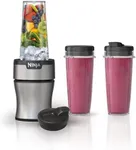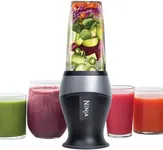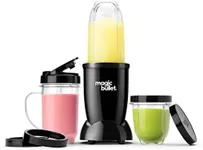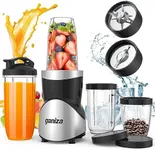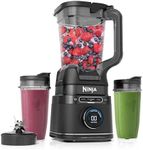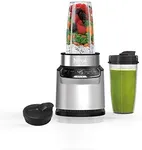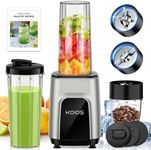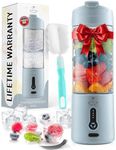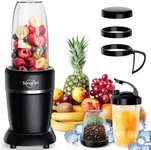Buying Guide for the Best Smoothies Makers
Choosing the right smoothie maker can make a big difference in your daily routine, especially if you love starting your day with a healthy drink. When selecting a smoothie maker, it's important to consider several key specifications to ensure you get the best fit for your needs. Understanding these specs will help you make an informed decision and enjoy delicious smoothies with ease.Power (Wattage)Power, measured in watts, determines how efficiently and quickly a smoothie maker can blend ingredients. Higher wattage means more power, which is essential for blending tough ingredients like ice, frozen fruits, and fibrous vegetables. Smoothie makers typically range from 200 to 1500 watts. For basic smoothies with soft fruits, a lower wattage (200-500 watts) may suffice. For more versatility and the ability to handle tougher ingredients, look for a machine with 600-1000 watts. If you plan to use your smoothie maker frequently and for a variety of recipes, consider models with 1000 watts or more.
CapacityCapacity refers to the volume of the blending jar, usually measured in liters or ounces. This is important because it determines how much smoothie you can make in one go. Smaller capacities (around 0.5-1 liter) are suitable for single servings or small households. Medium capacities (1-1.5 liters) are good for small families or those who like to make multiple servings at once. Larger capacities (1.5 liters and above) are ideal for larger families or for making smoothies in bulk. Choose a capacity that matches your typical serving size and how many people you usually prepare smoothies for.
BladesThe quality and design of the blades are crucial for effective blending. Blades are typically made from stainless steel for durability and sharpness. Some smoothie makers have multiple blades or specially designed blades to enhance blending performance. Look for models with strong, durable blades that can handle a variety of ingredients. If you plan to blend hard or frozen items frequently, opt for a smoothie maker with reinforced or multi-tiered blades for better results.
Speed SettingsSpeed settings allow you to control the blending process. Basic models may have just one or two speeds, while more advanced models offer multiple speed options and even pre-programmed settings. Having multiple speeds can be useful for achieving different textures and consistencies. For example, lower speeds are good for soft fruits and gentle blending, while higher speeds are necessary for crushing ice and tougher ingredients. If you like experimenting with different recipes, look for a smoothie maker with a range of speed settings.
Ease of CleaningCleaning your smoothie maker can be a hassle, so it's important to consider how easy it is to clean. Some models have dishwasher-safe parts, which can save you time and effort. Others have self-cleaning functions where you simply add water and a drop of dish soap, then run the blender to clean the jar and blades. Look for features like detachable blades and easy-to-clean materials. If you plan to use your smoothie maker frequently, ease of cleaning will be a significant factor in your overall satisfaction.
Noise LevelNoise level is an important consideration, especially if you plan to use your smoothie maker early in the morning or in a shared living space. Higher wattage models tend to be noisier, but some manufacturers design their products with noise reduction features. If noise is a concern for you, look for models that advertise quieter operation or have user reviews mentioning low noise levels. Balancing power and noise level will help you find a smoothie maker that fits your lifestyle.
Additional FeaturesSome smoothie makers come with additional features that can enhance your blending experience. These might include pulse functions, pre-programmed settings for specific types of smoothies, or even heating functions for making soups. Consider what additional features might be useful for you. If you like convenience and versatility, look for models with extra functions that align with your needs. However, if you prefer simplicity, a basic model with fewer features might be more suitable.
